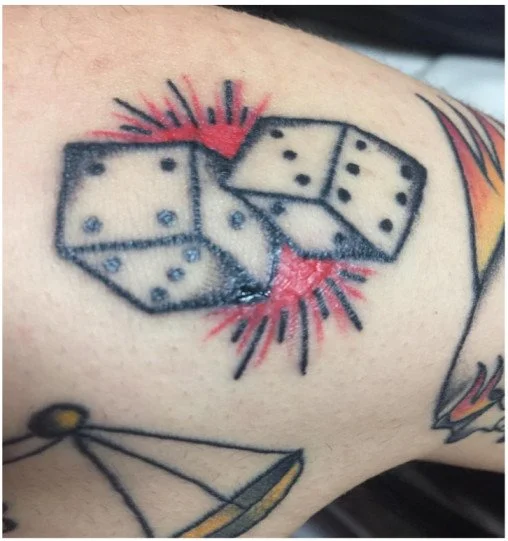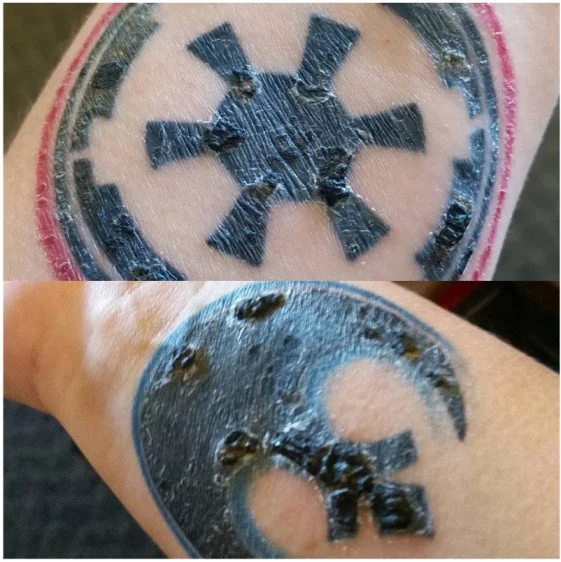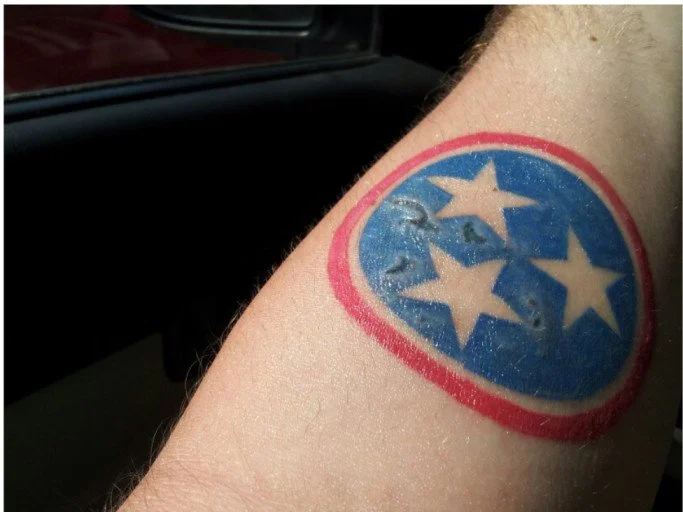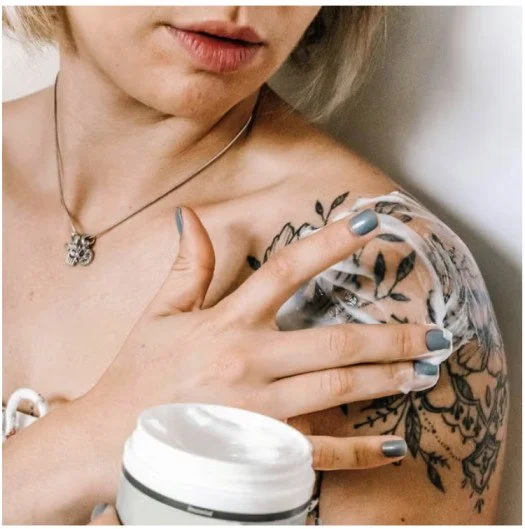Tattoo Cracking: Causes, Healing Tips, and Prevention
One of the most common concerns during the healing process is tattoo cracking. For someone unfamiliar with the healing process, it feels as if the design is being ruined before your eyes.
The reality is that skin cracking is a natural step in the skin's repair cycle. However, excessive cracking, bleeding, or persistent pain might signal that your skin needs more care. By learning what causes tattoo cracking and how to manage it, you can save yourself from unnecessary panic.
In this guide, we’ll explore the main causes of cracking, common symptoms, and practical ways to protect your tattoos.
Source: Last Sparrow Tattoo
What is Tattoo Cracking?
Tattoo cracking means the appearance of dry, flaky skin over a healing tattoo. It usually shows up within two weeks of getting inked, when your body is repairing the small wounds caused by tattoo needles. As tattoo scabs form, the skin tightens and loses moisture. That’s what creates the “cracked” look.
This happens during the inflammatory stage of wound healing, when scabs are forming and the new skin underneath is still fragile. After this stage, the body enters the proliferative phase, where new skin cells and collagen develop to replace the damaged tissue.
The process ends with the remodeling phase, when the skin strengthens and the tattoo settles into its final look.
Is Tattoo Cracking Normal? 7 Most Common Reasons
Tattoo cracking is a normal part of the healing process, so there’s no need to panic if you notice some flaking or dryness. In most cases, once the tattoo fully heals after a few weeks, it will look as good as new. However, cracking isn’t always harmless. Sometimes it can point to underlying issues, such as:
Source: Saniderm Knowledge Base
1. Excessive Scabbing
When your tattoo begins to heal, your body forms a protective scab over the wound. Normally, this scab is thin and flakes off gradually. However, if the scab becomes too thick, it loses flexibility. As the new skin underneath stretches, the hardened scab can split and appear cracked.
2. Dry Skin
Dehydrated skin loses its natural flexibility and becomes stiff, which makes cracks and flaking appear more obvious. This often happens when you forget to moisturize regularly or live in a dry or cold climate. In such conditions, the air naturally pulls moisture from the skin, which leaves it dehydrated and prone to cracking.
Additionally, exposing fresh tattoos to hot baths and saunas worsens the condition by stripping away the skin’s protective oils.
3. Infections and Allergies
Cracked tattoos combined with redness, swelling, pus, or severe pain may indicate an infection. This occurs when bacteria enter the open skin through contaminated water, unwashed clothing, or dirty hands touching the tattoo. If left untreated, the infection can worsen and delay the healing process.
In some cases, allergic reactions to the tattoo inks also cause similar irritation and flaking.
4. Inadequate Aftercare
Leaving your tattoo uncovered in dirty environments, scrubbing it with harsh, scented soaps, and forgetting to moisturize can interfere with the healing process. This leads to excessive cracking, which may distort the design or cause scarring.
5. Excessive Sun Exposure
Fresh tattoos are highly sensitive to sunlight, and direct UV rays can quickly dry out the skin, strip away its natural oils, and weaken the protective barrier that supports healing. When this happens, the tattooed area becomes more prone to cracking, irritation, and discomfort.
Research shows that exposing a healing tattoo to sunlight not only increases the risk of cracks but can also cause the ink to fade prematurely.
6. Overworked Tattoo
If a tattoo artist works over the same area repeatedly, the skin can become overworked and traumatized. This results in heavier, thicker scabbing, which is more likely to dry out and crack during healing.
7. Pre-Existing Skin Conditions
Skin conditions like psoriasis and eczema already cause dryness and irritation, which can lead to tattoo cracking. Even if your skin condition is under control, flare-ups during the healing period may compromise recovery.
When Tattoo Cracking Becomes a Red Flag
While mild tattoo cracking is normal, not all symptoms should be ignored. If these signs occurred, they could refer to infection, allergic reactions, or improper aftercare, and may require medical attention.
Source: Tacoma World
Red Flag #1: Tattoo Cracking and Peeling
Peeling is the most common and harmless form of tattoo cracking. During this stage, the tattoo may look dull, patchy, or uneven. But don’t worry, this is temporary. The underlying skin still holds the pigment, and once the peeling stops, your tattoo will appear vibrant again.
However, if you notice excessive peeling with severe itchiness, discharge, and swelling, it could indicate an infection or allergic reaction. The infection may also be accompanied by fever and redness, which may require antibiotics.
Red Flag #2: Tattoo Cracking and Bleeding
If your tattoo is cracking and bleeding, it usually points towards deep scabbing or an infection. Tiny drops of blood may appear during the early healing process, especially if the skin feels tight or is accidentally scratched.
However, continuous bleeding is not normal and should be assessed by a professional.
Red Flag #3: Tattoo Cracking With No Ink Underneath
Surface peeling is normal and doesn’t remove the design or pigment. It becomes problematic when large chunks of pigmented scabs come off prematurely. This usually happens when the tattoo is picked at, scratched or allowed to dry out excessively.
When pigmented scabs fall off too soon, they can leave behind patchiness or lighter spots in your tattoos. In severe cases, this can also cause scarring, which alters the skin texture and makes touch-ups more difficult.
Red Flag #4: Tattoo Cracking and Itching
Mild itching, alongside cracking and peeling, indicates your skin is healing. If the itching is severe, uncontrollable, with redness, rashes, or swelling, it can be an allergic reaction.
You could be allergic to the ink or to the products applied during aftercare. In this case, professional medical advice is necessary to prevent your condition from worsening.
5 Tips to Prevent Tattoo Cracking
A new tattoo is an open wound, and like any wound, how you care for it determines how well it heals. Cracking usually occurs when the skin becomes too dry or the scabs harden. But with the right routine, you can significantly reduce the risk. Here are five practical tips to keep your tattoo hydrated and healing beautifully.
Tip #1: Clean the Wound Regularly
Wash your tattoo twice daily with a fragrance-free, anti-bacterial soap and lukewarm water. This removes excess plasma, dried blood, sweat, and bacteria that could interfere with healing. Avoid scrubbing and only pat dry with a clean, soft towel, and allow the area to air-dry. Over-cleaning is equally damaging, as it can strip natural oils and worsen the dryness. The key is to keep the wound clean, without overdoing it.
Remember: Every artist recommends a different aftercare routine. Always discuss this with them in advance. In case the tattoo fades after the healing, some artists also offer free touch-ups, provided you follow their aftercare advice.
Tip #2: Follow an Aftercare Routine
Keeping the tattoo lightly moisturized, avoiding scratching, and applying healing ointments are important steps of an aftercare routine. Research shows that people who apply moisturizer during the healing process report significantly reduced or absent redness, edema, and discomfort. If you’re unsure which product would work best for you, ask your tattoo artist directly.
Tip #3: Avoid Hot Baths and Pools
One of the most common mistakes people make after getting a new tattoo is soaking it in water. Whether it’s a bath, swimming pool, hot tub, or even natural water sources like lakes and rivers, prolonged exposure can cause two major problems: it softens the scabs, and it exposes the tattoo to harmful bacteria that may lead to infection.
However, that doesn’t mean you have to avoid staying clean. Showers are perfectly safe, as long as you keep them short and avoid directing high-pressure or very hot water onto the tattooed area.
Tip #4: Stay Hydrated
Hydration isn’t just about what you apply to your skin; it also depends on how well you hydrate from within. Drinking around two liters of water a day helps maintain your skin’s elasticity, supports cell repair, and reduces the chances of scabs drying out and cracking.
In addition, be mindful of your environment. Arid climates, constant air conditioning, and excessive sun exposure can all sap moisture from your skin, putting extra stress on a healing tattoo.
Tip #5: Apply Healing Ointment
Fragrance-free and breathable products, such as Aquaphor and A&D ointments, provide a protective barrier while locking in essential moisture. Unlike heavy petroleum jelly, which can suffocate the skin and trap bacteria, these ointments are manufactured to hydrate without clogging pores.
Apply a thin layer, just enough to lightly coat the tattoo. Too much product can trap excess moisture and delay the natural scabbing process.
Tattoo Aftercare for Fast Healing (Day 1 to Day 15)
Preventing tattoo cracking ultimately comes down to consistent aftercare. The right routine speeds up the healing, while protecting your tattoo from scarring, infection, and excessive cracking. Here are a few aftercare tips advised by tattoo artists:
Day 1-2: Keep the plastic wrap on for 3–4 hours after the process, or the adhesive film for up to 48 hours. Once removed, gently wash the area with lukewarm water and apply a breathable covering before bed. Ensure your sheets are clean to prevent exposure to bacteria.
Day 3: Wash the tattoo twice daily with the same gentle method. After drying, apply a thin layer of healing ointment to prevent tattoo bubbling. Always use a clean towel to pat dry the tattoo.
Day 4–15: By this time, your tattoo will likely start to peel and flake. Switch from ointments to a light moisturizer and resist the urge to pick on the scabs. Avoid picking at the scabs. If itching becomes uncomfortable, resist scratching, gently pat or lightly slap the area instead to relieve the sensation.
Keep Your Tattoo Vibrant and Healthy
Tattoo cracking can look concerning, but it’s a sign your skin is repairing itself. However, not all cracking is normal. If you notice excessive bleeding, oozing, or prolonged redness and swelling, consult a professional artist or dermatologist.
At Studio Aureo Roma, our experienced artists guide you through every stage, from designs to aftercare, so your tattoo heals fast. Book your appointment today if you want your tattoos to recover without any complications.
FAQs
How long does tattoo cracking last?
Tattoo cracking usually lasts 1 to 2 weeks, depending on the size and location of the tattoo. Proper aftercare, including gentle washing, hydration, and regular moisturizing, can manage the cracking and speed up healing.
How many times should you moisturize your tattoo?
Most professionals recommend moisturizing your tattoo 2 to 3 times per day using a fragrance-free, anti-bacterial soap. Apply a thin layer of moisturizer after washing your hands. If the tattoo is feeling extra dry and itchy, reapply a small amount of moisturizer in between washes.
Can dry skin ruin a tattoo?
Dry skin can ruin a tattoo by causing extreme itching, tempting people to scratch their tattoos. This can cause premature removal of scabs that can pull out ink and damage the design. Severe dryness also causes scabs to harden and crack, which slows the healing and causes scarring or patchy color loss.




